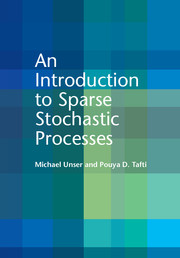Book contents
- Frontmatter
- Dedication
- Contents
- Preface
- Notation
- 1 Introduction
- 2 Roadmap to the book
- 3 Mathematical context and background
- 4 Continuous-domain innovation models
- 5 Operators and their inverses
- 6 Splines and wavelets
- 7 Sparse stochastic processes
- 8 Sparse representations
- 9 Infinite divisibility and transform-domain statistics
- 10 Recovery of sparse signals
- 11 Wavelet-domain methods
- 12 Conclusion
- Appendix A Singular integrals
- Appendix B Positive definiteness
- Appendix C Special functions
- References
- Index
4 - Continuous-domain innovation models
Published online by Cambridge University Press: 05 September 2014
- Frontmatter
- Dedication
- Contents
- Preface
- Notation
- 1 Introduction
- 2 Roadmap to the book
- 3 Mathematical context and background
- 4 Continuous-domain innovation models
- 5 Operators and their inverses
- 6 Splines and wavelets
- 7 Sparse stochastic processes
- 8 Sparse representations
- 9 Infinite divisibility and transform-domain statistics
- 10 Recovery of sparse signals
- 11 Wavelet-domain methods
- 12 Conclusion
- Appendix A Singular integrals
- Appendix B Positive definiteness
- Appendix C Special functions
- References
- Index
Summary
The stochastic processes that we wish to characterize are those generated by linear transformation of non-Gaussian white noise. If we were operating in the discrete domain and restricting ourselves to a finite number of dimensions, we would be able to use any sequence of i.i.d. random variables wn as system input and rely on conventional multivariate statistics to characterize the output. This strongly suggests that the specification of the mixing matrix (L−1) and the probability density function (pdf) of the innovation is sufficient to obtain a complete description of a linear stochastic process, at least in the discrete setting.
But our goal is more ambitious since we place ourselves in the context of continuously defined processes. The situation is then not quite as straightforward because: (1) we are dealing with infinite-dimensional objects, (2) it is much harder to properly define the notion of continuous-domain white noise, and (3) there are theoretical restrictions on the class of admissible innovations. While this calls for an advanced mathematical machinery, the payoff is that the continuous-domain formalism lends itself better to analytical computations, by virtue of the powerful tools of functional and harmonic analysis. Another benefit is that the non-Gaussian members of the family are necessarily sparse as a consequence of the theory which rests upon the powerful characterization and existence theorems by Lévy–Khintchine, Minlos, Bochner, and Gelfand–Vilenkin.
As in the subsequent chapters, we start by providing some intuition in the first section and then proceed with a more formal characterization.
- Type
- Chapter
- Information
- An Introduction to Sparse Stochastic Processes , pp. 57 - 88Publisher: Cambridge University PressPrint publication year: 2014



